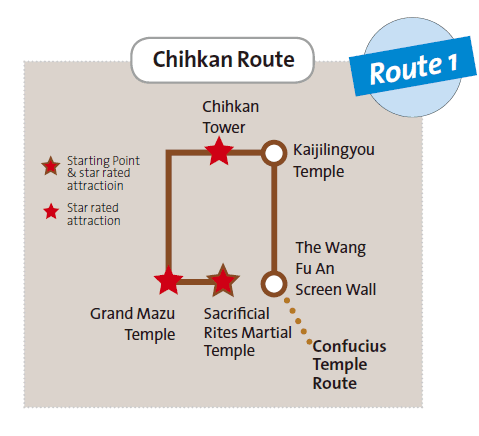The history and taste of the city of Tainan has long been a source of nostalgia and imagination for many. Taking a stroll through this cultural capital of Taiwan is arguably one of the most interesting and captivating ways of discovering all the city has to offer.
The Michelin Green Guide and Lonely Planet both nominated Tainan as a 3-star international attraction and a city which should be included in any travel plans. The magazines further listed the world class attractions, the Tainan Confucius Temple, Chihkan Tower, Grand Mazu Temple and Sacrificial Rites Martial Temple, as 3-star attractions. For this reason, the Tainan tourism bureau has strung together 7 “stroll friendly” routes each containing wonders befitting a 3-star Michelin tour.
The “Michelin 3-star tour” routes contain fragments of the rich history, culture and art that Tainan has to offer. To truly enjoy these routes and the unique taste of Tainan, tourists need only release themselves from the busy day to day routines, relax and go wherever feels right.
Having an In-depth Cultural Tour and Learning the History of Tainan
With the biggest grouping of historical sites in the whole of Taiwan, the two routes going through the Fucheng area yield many pieces of history. The first of which, the Chihkan route, contains an assortment of old temples, which tells the story of the establishment of the Fucheng area and indeed Taiwan itself. The second route, the Confucius Temple route boasts not only traditional Chinese architecture, but also a sense of what it was like during the Japanese occupation of Taiwan. The stark contrast between the modern and the traditional can be appreciated by taking a stroll through Fucheng.
Chihkan Tower
Built in 1653, the Chihkan tower is the most popular tourist attractions in Tainan. Elegant in design and elaborate in texture, Chihkan tower is most certainly a feast for the eyes.
Sacrificial Rites Martial Temple
Once declared a prestigious first class relic by the Qing Dynasty, the temple is the only temple in Taiwan to have a record of its worships. The temple itself worships the “Yue Xia Lao Ren”. This deity is said to control relations and marriages.
Grand Mazu Temple
Built in 1665, the temple is the first officially built temple in worship of Ma Zu, the diety which protects sailors from the perils of the ocean and has retained its magnificent Ming Dynasty architecture throughout the years.
Tainan Confucius Temple
Known as the “First School of Taiwan”, 5000 years of Confucianism and its seeds of culture can be seen here. The annual “festival of teachers” takes place here showcasing and continuing the traditional culture of the Chinese people. Opposite the temple is the famed Fuchong Street in which lies many traditional eateries.
National Museum of Taiwanese Literature
Inside this century old national historic site is Taiwan’s first national literature museum. With preservation of culture in mind, the building retains the French architecture style seen in and around the Tainan area.
Old Hayashi Department Store
The oldest Western department store of Taiwan, Lin department store was once abandoned, but through renovation has now been reopened as a cultural department store and is one of the most eye-catching landmarks of the city in Tainan.

Anping Old Street Walking Tour
To understand the origins of what we now know as Taiwan, there is no other place to visit than Anping Old Street. Through 3 centuries of change, the Anping district has birthed a multitude of unique historic landmarks.
Once called “Da yuan”, Anping is the origin of the name “Taiwan” and is the district with the most historic sites in Taiwan. Including such places as Anping Fort, Taiwan’s first stronghold, Dayuan port, Taiwan’s first international trading port and Old Tait?Co.Merchant House, You guessed it, also Taiwan’s first merchant house, Anping is also a home to many traditional snacks such as prawn rolls and sweet tofu curd.
Anping Fort
Erected by the Portuguese in 1624, the fort was Taiwan’s earliest stronghold. During the Japanese Occupation of Taiwan, Anping Fort received a makeover and above it were built arch type mansions and a lighthouse from which a 360 degrees view of the surrounding city can be found. Extending from the east end of Anping Fort is Yanping Street and was the first street to be built in Taiwan.
Former Julius Mannich Merchant House
During the later years of the Qing Dynasty, the ports in the Anping area were opened for international commerce making for the ideal environment for the establishment of different merchant companies including Tait & Co., Julius Mannich & Co., Ellis & Co. and others. While today Tait & Co. and Julius Mannich & Co. are the only 2 merchant companies whose buildings remain intact, the European style of building combined with a roof of Kinmen architecture, the Former Julius Mannich Merchant company building is most certainly unique.
‘Old Five Channels Cultural Route’ Daylight & Starlight
“Old Five Channels” literally translates to the five ports is an area that showcases Tainan in all its former glory. A busy pathway for commercial trading during the peak of the Qing Dynasty, the ports and their respective canal serve as an outlet for the cultural creations of the Tainan area in modern times. Many of the old buildings have been converted and remade with modern art and coupled with many traditional food staples of the Tainan area makes the Wu Tiao Gang area a great area for tourists to walk through.
In a fusion of old and new, this old city route is most suited for leisurely strolls. Touring this area on a dreary afternoon, one can appreciate the centuries worth of history these ports have ingrained in them and if one gets tired walking, there are many interesting and unique stores to which a tourist can sit down and enjoy a dish or two of traditional Tainan cuisine.
Temple of the Wind God
The only temple in Taiwan worshiping the god of wind, this monument was originally built to pray safe passages be given to sailors and ships sailing between the ports of Taiwan and Xiamen. The temple has once been named one of the eight greatest temples of the Qing Dynasty.
The Official Reception Pavilion
The gateway to Fucheng, this pavilion was once used to receive the officials coming from the mainland. With an elegance and commanding nature, the pavilion stands tall and proud to all that come before it.
Shennong Street
This little street brings about surprises at every corner and is truly inspiring under the light of sundown. With a taste of age old tradition mixed with the modernity of new art pieces and modern additions to its ageing buildings, Shennong Street is indeed a place with many quirks, which will pique the interest of all.
Hai'an Road
The hip and the new are all conjured up on this street and in stark contrast with the rest of the area. Hai'an Road is an exciting and lively place whether day or night.
Route of Yanshui and Yuejin Port
The history of the Yuejin port with all its local beliefs and traditional snacks have long been a staple of the town of Yanshui. With many temples and alleys crisscrossing the town, strolling through the town of Yanshui will allow you to feel the rich history of the eras slowly sink in.
Ciaonan Old St.
Located near the old port of Yuejin, this was the earliest street in the town of Yanshui. Ciaonan Old St. is a quiet and picturesque walkway for those looking for a walk through Yuejin Port Cinshuei Park.
Yanshui Dessert Town
As the name would suggest, those looking for a hearty bite to eat in the town of Yanshui must come here to put their taste buds through its paces.
Saline Public Temple
Located at what once was the Yuejin port, this temple was built to pray for sailors sailing between Taiwan and the Fujian province of mainland China.
The Octagonal Pagoda
The most unique building in the entire town of Yanshui would be the Octagonal Pagoda. With an octagonal exterior and amazing wood and bric craftsmanship, the Octagonal Pagoda was made to impress.
Strategy to touring the Guanziling Hot Springs
Known for its hot spring mud baths and surrounding mountains, Guanziling is the premier Taiwanese hot spring area and is the only hot spring area in Taiwan to receive the certificate.
Traditional bath houses and scenic areas have been preserved. When accompanied with traditional feasts, the Guanziling hot springs becomes one of the finer pleasures of the Tainan region.
Guanziling Old St.
Paved with stone bricks, the alleys of Guanziling Old St. mark the humble beginnings of hot spring tourism in the area. Many of the old bath houses have retained their traditional architecture and give a sense of travelling back in time when lavishing in their tubs.
Origin of the Hot Springs, the “Miraculous Hot Spring”
Since 1889, the Spiritual Spring has been the biggest source of hot springs in Guanziling. Tourists can see thermometers indicating the temperature of the Spiritual Springs. There is also a set of steep stone steps aptly named the “Hill of Men”.
Tainan City Hall has completed planning of the 7 “Michelin Strolling Routes” in order to allow tourists to get the fullest, most in depth experience of this traditional and historic region of Tainan. Using the 7 free recommended routes to see the sights of the city only takes a few hours.
To experience the free guided tours, please log on to Tainan City Government Tourism Bureau website to register.
Sponsored by the Tainan City Government Tourism Bureau











